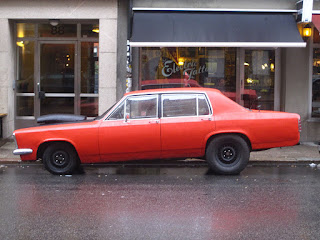We arrived in Stockholm on Sunday afternoon after a hell of a time in Oslo. We had bought some tickets to take the subway but the time started to seem like a bit of a crunch so we decided to take a cab. The driver dropped us off at the bus station right next to the train station because our ticket said we had to take a bus. After asking a bus driver going to Copenhagen and a worker at the window where our bus was, we were directed to go to the train station and beyond the last track, we would find a couple of buses to take us to Karlstad, where we would catch a train to Stockholm. We then had to run as fast as we could with a hundred pounds or so of luggage to the last train track and sure enough, there was a bus waiting on the other side of it. Ah, the little things that no one tells you. A bus will be sitting where a train track should be to do the work of a train. We made it, tired and soaked with sweat.
Once in Stockholm, we had another long trek with all of our luggage, 2.6 km to be exact. We hoofed it the entire way down cobbled streets and hills to our hostel and of course, when we get there at 2:20 in the afternoon, check-in isn’t until 3 p.m. We checked in and took a stroll around the area we were in, Old Town. We soon discovered that Stockholm is kind of a hidden jewel in Europe. I know people know of the city but it is absolutely beautiful and I can’t recall hearing that many people raving of going there. The buildings are big and bold and really nice to look at. It definitely makes a long walk more bearable when all of the things around you are capturing your full attention. Stockholm was set up in the 13th century on and would expand into its present form encompassing over 14 islands around the mouth of Lake Mälaren. It’s location makes it an important trading city and it was ranked at the second most visited city in Scandinavia after Copenhagen.We visited the area around the Royal Palace, the Rikstag(Parliament), and the Opera house. The palace was originally built in the 13th century as a single tower to defend the lake and eventually became the modern form it has. It hosts the Prime Minister and the offices of the royal family, headed by King Carl XVI Gustav.
After walking around these famous landmark buildings, we made our way out towards the island called Djurgården. We walked along Strandvägen Street, probably one of the most beautiful streets in the city in terms of architecture. The buildings are stunning, the street is on the waterfront, and it has a tree lined sidewalk that divides the traffic in the middle. There are loads of nice boats that have been restored and are used as a partial residence by rich people or tour boats. There also are a lot of small cafes and bars that offer great seats to sit and enjoy some coffee or a beer with the view. We walked towards a large building we saw on the island in the distance and felt completely captivated by the city in the meantime. After finally arriving to our destination, we discovered it was a museum called the Nordiska Museum. It’s dedicated to the ethnography of Sweden from the 16th century to the present. Instead of checking out the museum, we walked through the small park across the street and then headed north to find a place to eat.
We ended up eating some cheap Chinese that was nothing worth noting except the dessert. Fried bananas with a butterscotch sauce and ice cream. It made the mediocre food worth it. We also noticed a large collection of classic type cars around the city. We snapped a few photos of them. Enjoy the pictures.























No comments:
Post a Comment